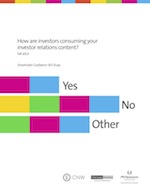Who visits and for what? An aficionado has been getting answers
What proportion of your shareholders visit your IR website every few months [correction - this should say 'only once a quarter']? What proportion never do at all? The answer to both is nearly 25 percent, a new report says.
In other words, IR websites are vital but underused. That’s one interpretation of PR Newswire’s study, ‘How are investors consuming your investor relations content?’
The survey was devised by Bradley Smith, PR Newswire’s director of marketing and self-confessed ‘IR website aficionado’. Every two weeks he emails a single question to a list of 20,000 professional and retail investors, a methodology aimed at increasing response and reducing survey fatigue. The new report sums up 27 of these mini-surveys with a minimum of interference – simple graphs, comments and a brief conclusion from Smith.
The report is posted on IR Magazine’s website as part of a paid sponsorship arrangement.
Smith is an astute observer of IR websites having worked at Shareholder.com before and after its acquisition by NASDAQ. A pioneer blogger in the IR sphere, he has always made his objective clear: he’s a marketing officer selling products and services – including PR Newswire’s IR Room for creating and hosting IR websites. But he is also intent on uncovering points of best practice for IROs.  ‘I wanted to know very tactically who is looking at all this stuff on IR websites and how investors are consuming the content,’ Smith says. ‘If 25 percent of users only go to company websites once a quarter, then companies are spending $15,000 a year and up on a tool that’s just sitting there.’
‘I wanted to know very tactically who is looking at all this stuff on IR websites and how investors are consuming the content,’ Smith says. ‘If 25 percent of users only go to company websites once a quarter, then companies are spending $15,000 a year and up on a tool that’s just sitting there.’
Smith’s point is not that the spending is wasted but that it may be misdirected. He doesn’t doubt websites are critical; over half of the investors he surveyed said they wouldn’t invest in a company unless it had an IR website.
But Smith wants companies to focus on what counts, not on unused features. For example, only one in 250 respondents regularly look at stock charts on company websites, so they should be nixed. But over 20 percent go to company websites for SEC filings, so they should be easy to access.
Other lessons: around 70 percent said live video webcasts of a company’s CEO would inspire more trust (kudos to Netflix and Yahoo), and around half said they read transcripts of earnings calls. ‘Yet most companies don’t post transcripts. If they did, they’d attract more traffic, and investors would get other color while they’re there.’
Most of Smith’s survey list is an opt-in audience from RetailInvestorConferences.com, of whom half are members of BetterInvesting, the retail investment organization.










